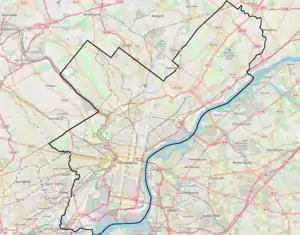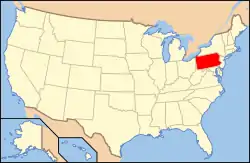Marian Anderson House
The Marian Anderson House is a historic home located in the Southwest Center City neighborhood of Philadelphia, Pennsylvania. Built circa 1870 in the same neighborhood where opera singer and civil rights advocate Marian Anderson was born 27 years later, this two-story, brick rowhouse dwelling was designed in the Italianate style. Purchased by Anderson in 1924, the same year she became the first African-American concert artist to record spirituals for a major American recording company, she continued to reside here until 1943.[2]
Marian Anderson House | |
 Marian Anderson House, June 2011 | |
   | |
| Location | 762 South Martin Street, Philadelphia, Pennsylvania |
|---|---|
| Coordinates | 39°56′32″N 75°10′29″W |
| Area | less than one acre |
| Built | c. 1870, c. 1925, c. 1940 |
| Architectural style | Italianate |
| NRHP reference No. | 11000198[1] |
| Added to NRHP | April 14, 2011 |
History and architectural features
The Marian Anderson House was built circa 1870 as a two-story, brick terraced dwelling in the Italianate style. A studio was added above the previously one-story, rear kitchen ell sometime around 1925. The home was then extensively renovated circa 1940. It served as the residence of opera singer and civil rights advocate Marian Anderson from 1924 to 1943. The property currently houses the Marian Anderson Historical Society.[3]
Placement of this property on the National Register of Historic Places
The nomination materials for placement of the Marian Anderson House on the National Register of Historic Places were reviewed by Pennsylvania's Historic Preservation Board on February 1, 2011 at 9:45 a.m. at the Labor and Industry Building in Harrisburg, Pennsylvania. Also considered for National Register placement at this meeting were: the Robb Farm in Huntingdon County, the McCook Family Estate and the John A. Brashear House and Factory in Pittsburgh, the Montrose Historic District in Susquehanna County, the Quakertown Historic District in Bucks County, Wilpen Hall in Sewickley, Alden Villa in Lebanon County, and the Tindley Temple United Methodist Church in Philadelphia, as well as multiple historic African American churches in Philadelphia that were presented together on a "Multiple Property Documentation Form."[4]
This historic residence was then officially added to the National Register of Historic Places later in 2011.[1][5][6]
References
- "National Register of Historic Places Listings". Weekly List of Actions Taken on Properties: 4/11/11 through 4/15/11. National Park Service. 2011-04-22.
- "Marian Anderson Historical Residence & Museum: Preserving the legacy of one of the world's greatest contraltos," in "Visit Philly." Philadelphia, Pennsylvania: City of Philadelphia, retrieved online September 29, 2019.
- "National Historic Landmarks & National Register of Historic Places in Pennsylvania" (Searchable database). CRGIS: Cultural Resources Geographic Information System. Note: This includes Lindsey Allen (December 2010). "National Register of Historic Places Registration Form: Marian Anderson House" (PDF). Retrieved 2012-07-05.
- Marian Anderson House, in "Historical and Museum Commission: National Register Nominations to Be Reviewed by the Historic Preservation Board," in Pennsylvania Bulletin, Vol. 41, No. 3, January 15, 2011, pp. 420-421. Harrisburg, Pennsylvania: Commonwealth of Pennsylvania, 2011.
- "William Penn's Legacy: A Tradition of Diversity." Harrisburg, Pennsylvania: Pennsylvania Historical and Museum Commission, 2010-2011.
- "Department of the Interior: National Park Service: National Register of Historic Places; Notification of Pending Nominations and Related Actions," in Federal Register, Vol. 76, No. 61, March 30, 2011, p. 17670.
External links
- Marian Anderson Historical Society website
- "Visions 2018: Touring the Marian Anderson Museum" (video). Philadelphia, Pennsylvania: ABC-6 TV, February 12, 2018.

